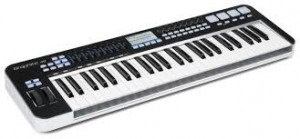 As is probably obvious by now, I’m involved in playing for (and MDing) a musical I co-wrote, this summer. So is my wife, Anne – she’s doubling on flute and keyboards.
As is probably obvious by now, I’m involved in playing for (and MDing) a musical I co-wrote, this summer. So is my wife, Anne – she’s doubling on flute and keyboards.
A lot of the songs from this show date back to the early 90s, or from recordings made in the late 90s, and the ‘definitive’ recordings of them are very much layered with the keyboards sounds we had available to us at the time: specifically, a Roland XP80, Alpha Juno 2 and D10 and a Korg X-5D (what can I say? We weren’t made of money back then!). Anne’s very fond of a couple of patches on the Juno, and for all we tried to emulate them on the XP80 and/or the X-5D, it’s not the same.
While I was pondering this, I had my attention drawn to an article and a series of videos from Keyboard magazine about the 2012 Springsteen tour, particularly how David Rosenthal had replaced all of their old legacy boards with a hi-tech modern virtual rig, featuring Apple’s MainStage and a few other tools. Actually, ‘had my attention drawn to’ doesn’t begin to cover it – ‘had my socks blown off by’ would be closer. Essentially, he completely cloned and replaced the rig during tour rehearsals, essentially without the (somewhat fussy) keyboard players and techs actually noticing.
“What the heck”, I think. “If it’s good enough for Springsteen, it’s good enough for my wife…” (Anyone who doesn’t understand that, clearly isn’t married!)
First steps, then, were to gather the hardware.
Anne’s pride and joy is her Roland XP-80 – she’s had it since new, and loves both the 76 notes and the semi-weighted feel. Like it or not, this is going to be her master keyboard. It also has the advantage that we can program an emergency bank of patches (strings, choir pad, piano, organ etc) in the event of the virtual rig going down. (Always, always, think about failure and backups!).
On top of that, she wants a second keyboard: for reasons I don’t understand, she really doesn’t like patches with splits in, even though modern technology allows for smart splits where the split point moves in the context of your playing. I did consider using either the Juno or the D-10, but both have had repairs in the past year or two, and I’m loath to risk what are actually 30+ year old keyboards for a one-off but critical performance. After a bit of shopping around, and checking that she wasn’t going to complain about only having four octaves, I went for a Samson Graphite 49 – I’ll do a full review later, but basically it’s a 4 octave USB/MIDI master keyboard with an array of assignable knobs, sliders and pads.
So there’s two keyboards. For the virtual part of the rig, I have a spare (it’s a long story) 2012 MacBook Pro, from which we removed the boot drive, and replaced it with a Seagate 1TB hybrid drive (basically, it’s a mixed SSD and normal drive with some smart software that keeps the regularly accessed data on the SSD portion), 16GB of RAM and a fresh clean install of OS X. Needless to say, this absolutely flies!
On top of that, we needed a MIDI interface – a M-Audio Midisport 4×4 – and a decent audio interface. This latter is made a little harder by the fact that the MacBook Pro only has two USB ports. I did consider a USB hub, but that’s just more cabling, so we went for the M-Audio Firewire Solo that we’ve had lying around for a while.
Off then went the rather large order to Amazon, for that little lot plus a bunch of MIDI cables, some doubled jack-to-jack leads, a pair of Behringer mic-stand mounted monitors (Anne’s been using a very vintage Sharma 2×12″ keys combo for heaven knows how long), a small Behringer Xenyx 1002B stereo mixer and a Stagg laptop stand.
Next time? Putting it all together.
